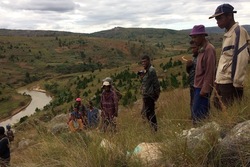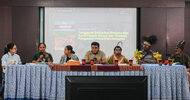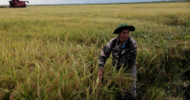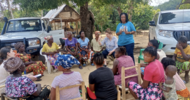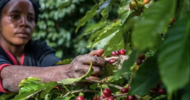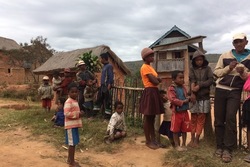
François Rakotonirina (far right), encouraged a Mongabay reporter to take as many photographs of his village as possible. “Show them everything we have here,” he said. “Our rice fields, our houses, all the things we don’t want to give up.” (Photo: Edward Carver for Mongabay)
In Madagascar, villagers oppose plans for a dam that would inundate their land
BY EDWARD CARVER
Mongabay Series: Conservation in Madagascar
-
A dam project in Madagascar’s central highlands, still in its planning stages, would submerge several villages, forcing hundreds or thousands of people out of their ancestral homes.
-
Residents at risk of being displaced oppose the dam, and civil society groups argue that its potentially large size and social impact are not justified by the relatively small amount of power it would produce.
-
The Italian company behind the project insists it’s not yet clear if the project is feasible and has made no definitive plans to build the dam.
SAHANIVOTRY COMMUNE, Madagascar — The village of Farihitsara in Madagascar’s central highlands was littered with straw from the rice harvest when Mongabay visited in May. But people weren’t able to enjoy the relief that comes with the end of the hungry season. Instead, they were anxious about a dam project that could put their village permanently under water.
A farmer named François Rakotonirina urged this reporter to take as many photographs as possible. “Show them everything we have here,” he said. “Our rice fields, our houses, all the things we don’t want to give up.”
The dam project, run by an Italian firm and still in its planning stages, would create a large lake and force hundreds or thousands (the number is disputed) of people out of their ancestral homes in Farihitsara and neighboring villages. It comes as Madagascar’s government tries to keep its electricity sector afloat. Jirama, the state-owned electricity and water company, has been beset by corruption and mismanagement. Less than one-quarter of the country’s population has electricity, a figure that a recent World Bank report indicates has declined in the last decade and is now among the worst in the world.
Several large hydropower projects run by foreign firms are set to come on line in the next few years. Many are in remote locations where civil society groups are not able to operate. Tozzi Green, the Italian energy firm working on the dam near Farihitsara, happens to have chosen a location where people know how to make their voice heard.
Hot dam: The push for hydropower
Tozzi Green’s dam would increase the supply of electricity to nearby cities, including Antananarivo, Madagascar’s capital. The company already operates a power plant a few miles downstream on the same small river, the Sahanivotry. The plant was built in 2008 to have a 15 to 18 megawatt capacity, but irregular water flow has resulted in its actual output being dramatically lower. The new dam would regulate the flow of water so the plant can run all year and achieve its capacity, effectively doubling its annual electricity output. However, the result would still represent a relatively modest contribution to Madagascar’s power grid.
And so civil society groups argue that the large size and potential impact of the dam is unwarranted. The dam would likely be about 40 meters (130 feet) high and create a lake covering up to 1,000 hectares (almost 2,500 acres), the company acknowledges, yet it would add power for relatively few households, probably a figure in the tens of thousands.
Over the next five years, new dams elsewhere in the country should significantly increase the country’s capacity, which is currently only 684 megawatts, about one-quarter of which comes from hydropower. Three dams built by French firms will together add more than 550 megawatts to Madagascar’s grid, powering millions of households. And Tozzi Green itself is building two other dams that will produce 68 megawatts, much more than the one near Farihitsara.
The World Bank has pushed Madagascar to invest in hydropower as a way of reducing reliance on imported fossil fuels. Almost one-third of the fuel that enters the country is used by Jirama, the public utility, to power its electricity generators. The cost of power generation, more than twice the average of neighboring countries, is such a drain on state finances that President Andry Rajoelina has started a dispute with the four main fuel suppliers: the government refuses to pay its bills until the suppliers agree to reduce the price of fuel. (Similarly, Tozzi Green claims that Jirama owes it more than $22 million in unpaid bills.)
The World Bank has criticized the opaqueness of the supply deals and called for major reforms at Jirama, which is also regularly criticized in the press after years of high-profile scandals and power outages.
Sustainability unknown
Though hydropower was once considered natural bounty, today scientists have a better understanding of the costs. It is renewable, but many environmentalists don’t consider it sustainable.
Dams convert large terrestrial ecosystems, including farmland, into lakes, and prevent fish from moving upstream to access critical habitat. Downstream, they cause sediment to trap and alter the natural flows of water that fish depend on to get to floodplains for breeding. Mitigation techniques such as fish ladders or the release of seasonal flows tend to be costly for companies and are seldom written into government contracts.
“If you build in the social and environmental costs of dams, other renewable options often make much more sense,” Matthew McCartney, a hydrologist at the International Water Management Institute, a Sri Lanka-based research group that works in Africa and Asia, told Mongabay.
Little is known about the potential environmental impact of the Farihitsara dam, as a complete study has not yet been conducted. Alessandro Berti, country director for Tozzi Green in Madagascar, spoke with Mongabay at the company’s sleek office in Antananarivo, located near the top of the tallest building in the country, but the company declined to share its preliminary findings or other requested documents and did not respond to emailed follow-up questions.
Connected to power
Tozzi Green is owned by the Tozzi family but will soon be publicly listed in Italy. Its subsidiaries in Madagascar, which work not just in energy but also agribusiness, spices and essential oils, have 350 permanent employees.
The company also has the government’s support. Weeks after Andry Rajoelina was sworn in as president earlier this year, founder and chairman Franco Tozzi was knighted for the company’s agribusiness work in Madagascar’s south, where it operates about 7,000 hectares (roughly 17,300 acres) of land. Collectif TANY, a Malagasy civil society group based in Paris, has questioned the company’s acquisition of that land, calling it a “land grab.” Tozzi Green has said that such claims are false.
Tozzi Green has long-standing ties to Hery Rajaonarimampianina, Madagascar’s president from 2014 to 2018 and finance minister from 2009 to 2013. Rajaonarimampianina’s accounting firm, Auditeurs Associes CGA, used to run Tozzi Green’s books. Tozzi Green acknowledges its old ties to Rajaonarimampianina but says that the close relationship would have existed even if he’d never been the company’s accountant. “We are the biggest hydro operation in Madagascar, and we are the biggest commercial agribusiness company in Madagascar,” Berti said. “We are a very important economic operator in this country … So it’s quite normal that we have a relationship at this level.” He said Tozzi Green had never given money to the campaign coffers of Rajaonarimampianina, Rajoelina, or any other politicians, despite many requests.
A Tozzi Green guard restricts access to the long road that leads to its power plant. Local people’s dislike of the fact that they cannot use the road has contributed to the company’s mixed reputation in the area. Image by Edward Carver for Mongabay.
‘Not a story’
The controversy surrounding the Tozzi Green dam has been covered in national media outlets and followed closely by a regional radio station affiliated with the Catholic Church. Civil society groups such as Transparency International – Initiative Madagascar and Liaison Office of the Rural Trainer (BIMTT), which represents the interests of rural farmers, have criticized Tozzi Green for its lack of transparency on the project. Yet Berti said the attention is unwarranted and the opposition is “politically motivated.”
“I’m sorry for your story but I’m afraid it’s not a story,” Berti told Mongabay. He said repeatedly that the company did not know if the project was feasible and had made no definitive plans. “We made a couple of drillings in the mountains, that’s it.”
However, the people of Farihitsara believe there is a story and worry that it will have an unhappy ending. Rumors about the project abound. Research drones arrived without warning, frightening local residents, who aren’t sure where they would be moved if the project comes to pass. Some have lost motivation to work the fields for fear they will suddenly be dispossessed of their land. Indeed, several people said that Tozzi Green employees have already come to Farihitsara with images and maps that show the village would become a lake.
There are signs that the project will move forward. The company has begun holding occasional meetings with stakeholders, including village representatives.
Noely Ranaivosolo, a 57-year-old farmer who leads a local opposition group, said he found it difficult to speak up during the meetings, which are sometimes attended by officials from the regional government or the energy ministry. “We [the village representatives] talked about what makes us human and our beliefs, the Bible,” he told Mongabay after one such meeting in the village of Sahanivotry, the seat of the commune (essentially a county) by the same name, in May. “Talking about the law, we aren’t too familiar.”
The power to decide
Even the mayor of Sahanivotry commune, Raymond Rakotonirina, who lives well outside the dam’s potential impact zone, strongly opposes the project. But he is powerless to stop it, he said, adding that decisions come from the central government. He cited the company’s recent exploratory drilling as an example. “We couldn’t stop it,” he told Mongabay. “The authorization came from the [energy] ministry. They sent it to us just for our information. If it had been our decision, it would have been another situation.”
He also said that Tozzi Green’s mixed reputation in the area has fueled opposition to the project. Though the company employs local day labor at its plant, and recently electrified 200 houses in the village of Sahanivotry, the mayor said he believes its overall social record is poor. “Only this electricity provision has been done in 10 years,” Rakotonirina said.
Farihitsara and other villages that could be affected by the Tozzi Green dam project do not have electricity, but that’s not unusual for rural villages, even when they are near power plants: only about 6 percent of Madagascar’s villages have electricity.
The mayor also voiced frustration about the lack of information regarding the dam project. “We do not know the number of people to be displaced,” Rakotonirina said. “They don’t want to reveal the truth. When we ask them for information, Tozzi Green keeps saying that they are still making studies.”
An uncertain future
Because there are no definitive plans, it’s impossible to know how many people could be affected. Tozzi Green acknowledges that four villages would be inundated under its tentative plans and says that about 150 households would have to be moved.
However, civil society groups dispute those figures. BIMTT says that with a height of 40 meters the dam would inundate 680 hectares (about 1,700 acres) and force thousands of households to relocate. BIMTT built a 3D map of the Sahanivotry area based on data obtained from the Geographical and Hydrographic Institute of Madagascar (FTM). However, BIMTT has no study to back up its claims. The group says that such a study would be premature, as there is no guarantee that the dam will be 40 meters or less, and that the first step is for Tozzi Green to present its studies and plans openly. Tozzi Green, meanwhile, is critical of BIMTT’s initial analysis, saying that it’s based on erroneous population figures.
A communications officer from the energy ministry told Mongabay that it had granted Tozzi Green permission to conduct studies but had not yet amended the company’s concession to include the proposed dam site. Tozzi Green said it has not yet requested environmental permits, as it is still conducting studies. The company is in the final stages of negotiations with Insuco, a consultancy with offices two floors up from Tozzi Green’s in the same skyscraper, to do an environmental and social impact assessment and a resettlement action plan. These studies will cost Tozzi Green “a couple hundred thousand dollars,” Berti said.
Berti said the dam might be built in three years’ time if the project moves forward. He indicated that it could be a boon to the local economy, and drew comparisons to Lake Mantasoa, a tourist destination in Madagascar’s central highlands that was created when the French built a dam there in the 1930s. That lake has a surface area of 2,000 hectares (almost 5,000 acres); Berti said the new lake wouldn’t be as big.
Ultimately, it could come down to a question of compensation in the form of money or land. During a televised debate on the dam controversy, representatives of Madagascar’s energy ministry aligned themselves with Tozzi Green and promised local village representatives that residents would be compensated appropriately when their land was expropriated.
“They just want to give us money,” said Noely Ranaivosolo, the opposition group leader in Farihitsara, whose extended family has been farming the land for generations. “But we’re not sure how we will live.”


